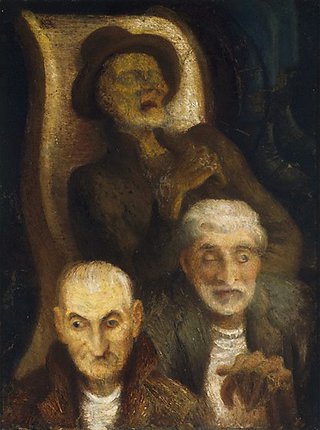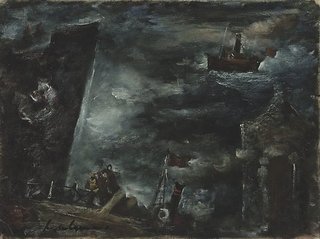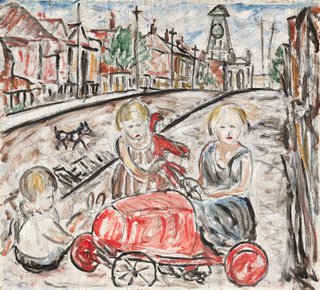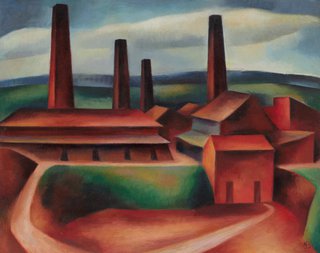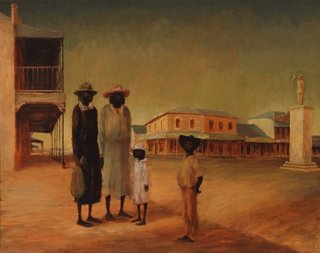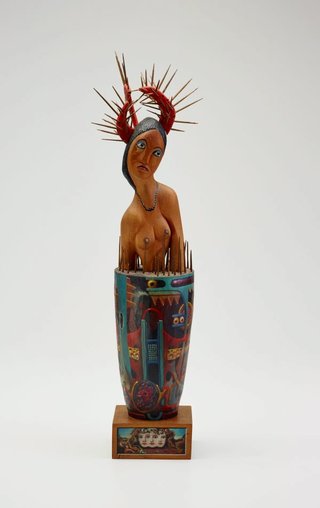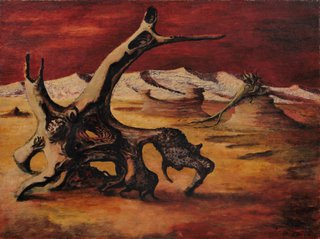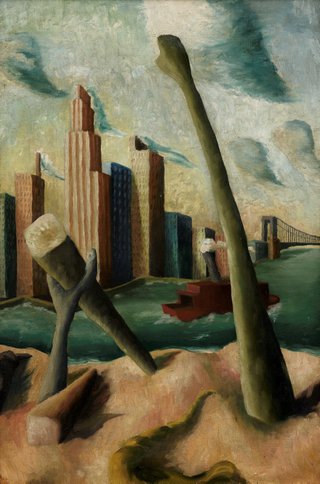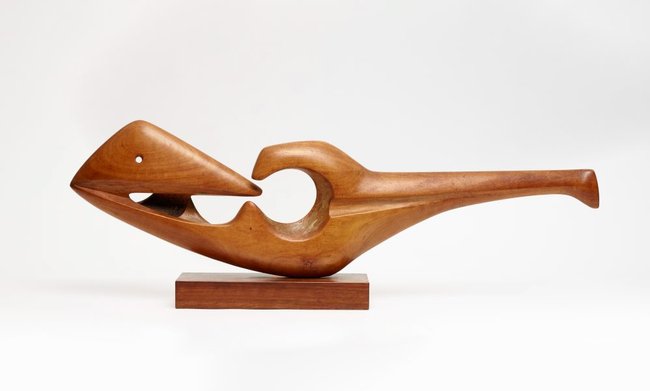Art Sets.
20th-century Australian art: Surrealist impulse and social realism
Print this setBy the Art Gallery of NSW
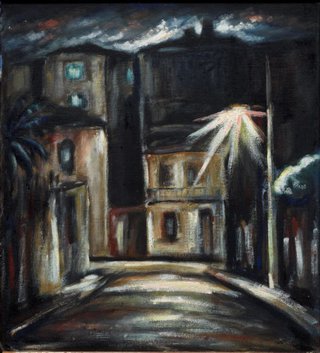
AGNSW collection Danila Vassilieff Nocturne no. 3, Commonwealth Lane 1936
Danila Vassilieff was a Russian refugee who escaped the Revolution by immigrating to Australia in 1923. He is credited with pioneering figurative expressionism and social realism in Australian art during the 1940s.
Nocturne no 3, Commonwealth Lane dates from Vassilieff's Sydney period (1935-36), when he had returned to Australia after several years spent travelling, working, and exhibiting throughout Asia, Europe, South America, and West Indies. It was displayed in the artist's first Sydney exhibition at Macquarie Galleries, in 1936, which polarised critical opinion for being 'ultra-modernist'. The inner-city street scene depicts the facades of terraced houses - since demolished - illuminated by a lone street light at night. Painted with spontaneity in a tertiary palette from his Surry Hills studio, Vassilieff's representation of his newfound urban environment is fervent and defining.

AGNSW collection Noel Counihan In the waiting room 1943
Although he personally never experienced poverty during the Depression, Counihan lived for a year on the dole when he was twenty and depicted the life of the unemployed in an exhibition of drawings held in 1934. Co-founder of the Workers Art Club with Jack Maughan and Nutter Buzzacott, he joined the Young Communist League in 1931, and joined forces with Yosl Bergner and Vic O’Connor in forming the social realist faction of the Contemporary Art Society in 1942, fired by communist ideology and concerned with social injustice and the condition of man. In 1946 he exhibited with O’Connor and Bergner in Three Realist Artists at Myers Gallery.
In the waiting room, painted when Counihan was recuperating from tuberculosis, reveals an affinity with the German artist Kathe Kollwitz as well as other European artists, including Honoré Daumier, Francisco Goya and Ernst Barlach.

AGNSW collection Dorrit Black Mirmande (with surrounding hills) 1934
Dorrit Black first travelled to Mirmande in France in 1928 when she enrolled in the the school of painter André Lhote. Mirmande remained entrenched in Black’s artistic imagination and she returned in 1934 to once again sketch the pyramidal structure of the medieval hilltop village, later developing these works into paintings including Mirmande (with surrounding hills).
Mirmande represents the subject with which Black first interrogated ideas of painting the modern landscape. Here we see the aesthetic elements that she would apply to her subsequent Australian landscapes: indelibly solid where driven by a dynamic, rhythmic structure, and coloured in earthy sombre hues. Black’s moody landscapes instil a sense of sombre monumentality. As one critic wrote in 1936: 'Miss Black’s theory of art is often an introspective and rather melancholy one.'
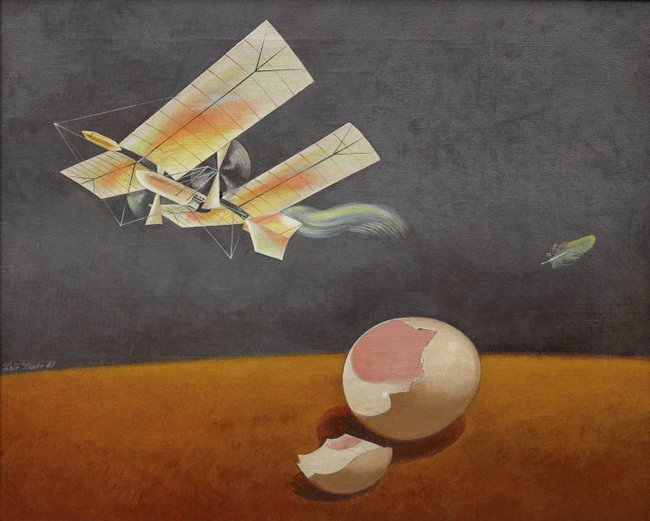
AGNSW collection Eric Thake Archaeopteryx 1941
A prolific printmaker known for his ingenious linocuts, Eric Thake considered his rarer oils and watercolours of greater significance. He studied at the National Gallery of Victoria Art School and later with George Bell, whose interest in formal design and abstraction through pictorial organisation, as well as the theory of dynamic symmetry, influenced the young artist.
By the late 1930s, Thake's work revealed an awareness of the metaphysical experiments of Giorgio de Chirico and the English surrealists Edward Wadsworth and Paul Nash. Archaeopteryx is a superb example of Thake's meticulous and witty paintings, its directness derived from his experience as a graphic artist and medical illustrator. The inspiration for the work was a book by Willy Ley in which Australia is described as a world's-end warehouse of nature's experiments: the lizard-like head and feathered body of the flying machine evokes the prehistoric creature of the title.

AGNSW collection Eric Wilson Hospital theme - the sterilizer 1942
At the time this painting was created, Eric Wilson was working as a ward attendant at Sydney's Lidcombe State Hospital. Drawing inspiration from his surroundings, the subject of this painting is an autoclave – a machine that heats liquids above boiling point to obtain sterilisation. Instead of portraying the machine from a single vantage point, Wilson has embraced cubist theories which attempted to convey three-dimensional objects from several angles at once.
In his later career, Wilson championed cubism in both his teaching and exhibited works, such as Hospital theme – the sterilizer, which was shown at the fourth annual Contemporary Art Society exhibition in 1942.

AGNSW collection James Gleeson The sower 1944
I think that there was always the hope that it could influence the way people thought about war. That it could alert people to its horrors and prevent it occurring again. You see, I was born during the First World War in 1915, and my earliest experiences were with people who were in that war or remembered the war very vividly, and then, just when I was beginning to paint, the Second World War began. So war became a kind of lurking terror in my mind from infancy through to late adolescence, when it was all building up again for another one.
I had Millet’s Sower in mind when I painted it. This is a 20th-century ‘Sower’ and the dislocated limbs represent humanity out of gear, the bleak landscape represents the present period, whereas Millet’s landscape showed fertility.
James Gleeson, 1993

AGNSW collection Russell Drysdale Aboriginal stockmen circa 1953
In 1951 Russell Drysdale travelled to Cape York Peninsula in northern Queensland where he developed an interest in Indigenous Australians as a subject for his work. Many of the paintings he produced during this time depict Aboriginal subjects in urban and rural settings, and reveal the artist’s objective compassion toward the people he met and painted. These works formed a significant social comment on the sense of displacement experienced by Indigenous people during the early 1950s in Australia.
Station boys emanates from this period and presents two young Indigenous Australian stockmen standing side-by-side in a photographic-type format. Portraying the young men at a close proximity – in comparison to related works, such as Group of Aborigines – the painting establishes a more intimate connection between its subject and the viewer.

AGNSW collection Russell Drysdale Sofala 1947
Sofala is regarded as one of Russell Drysdale's finest paintings, representing the artist at the height of his powers. With its compelling evocation of atmosphere and ambience, the painting transcends literal description of a particular place to become an expression of the quintessential qualities of an inland Australian country town.
Drysdale first visited this former gold-mining settlement in August 1947 with fellow artist Donald Friend. He made a sketch and took photographs but, as was customary for him, completed the painting in his studio on returning to Sydney. In Sofala, Drysdale pares down the reality of the subject to its barest essentials, achieving an intensified synthesis of visual and emotional impact. His modernist focus on the construction of mood in this work marked a radical departure from the prevailing traditions of Australian landscape painting.
